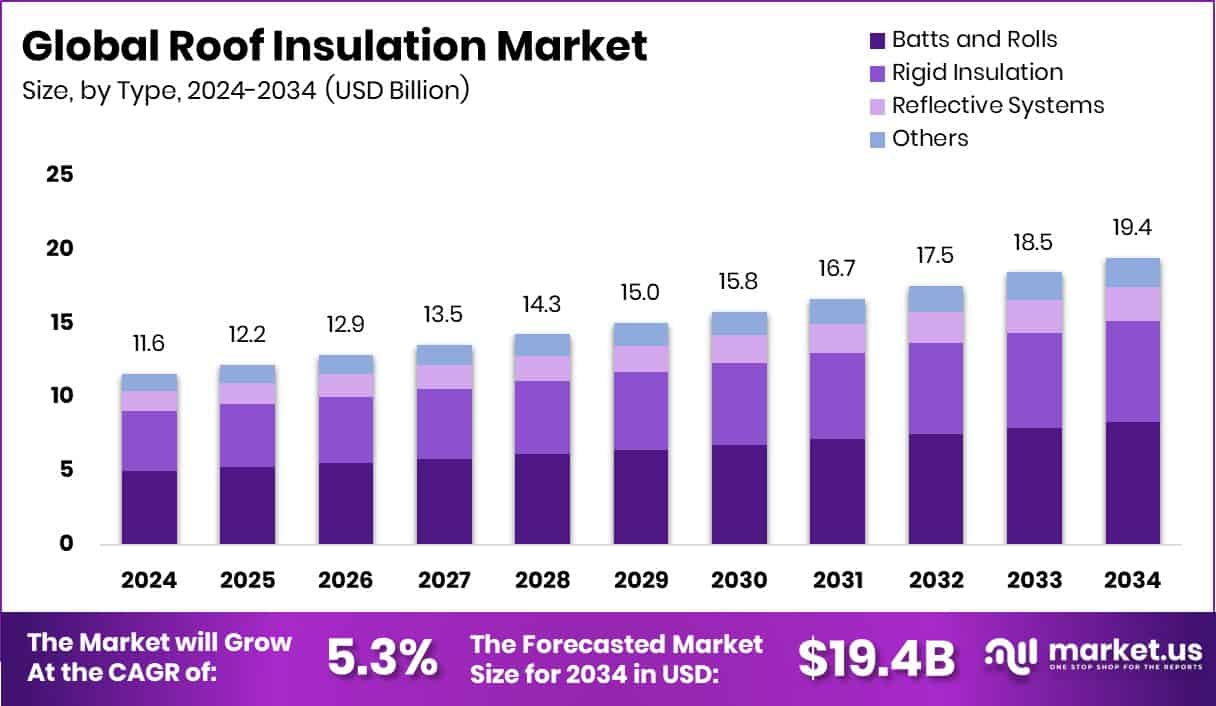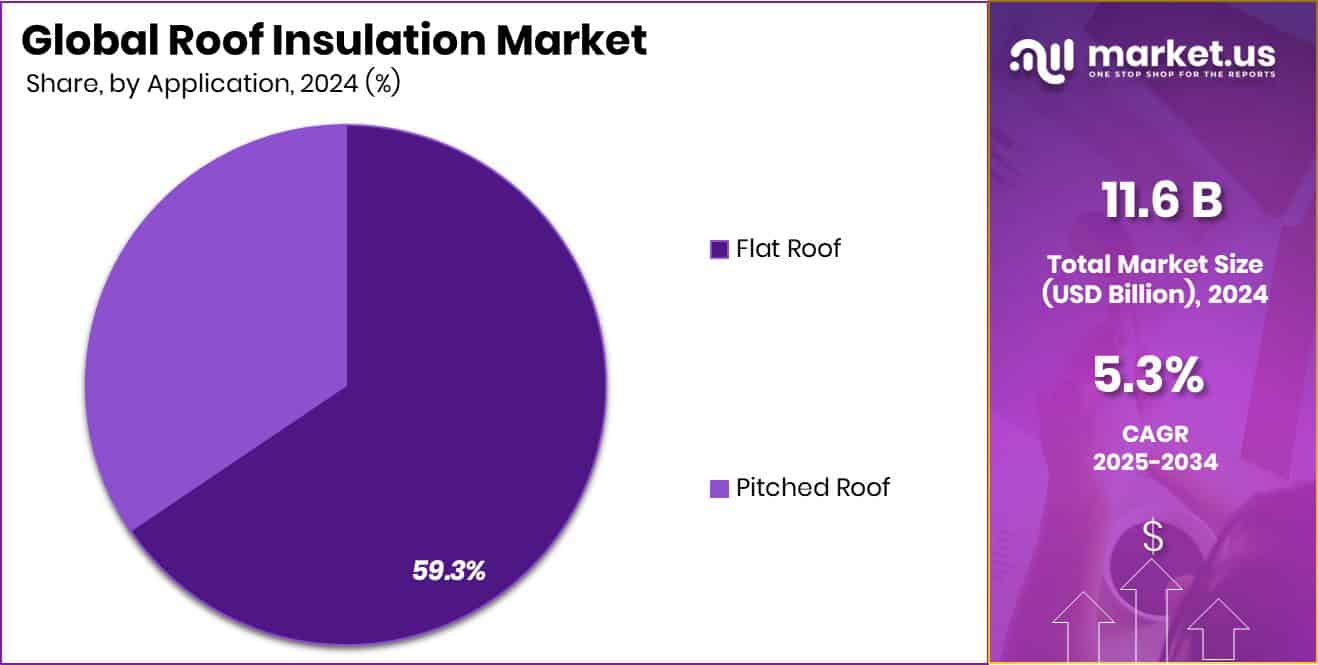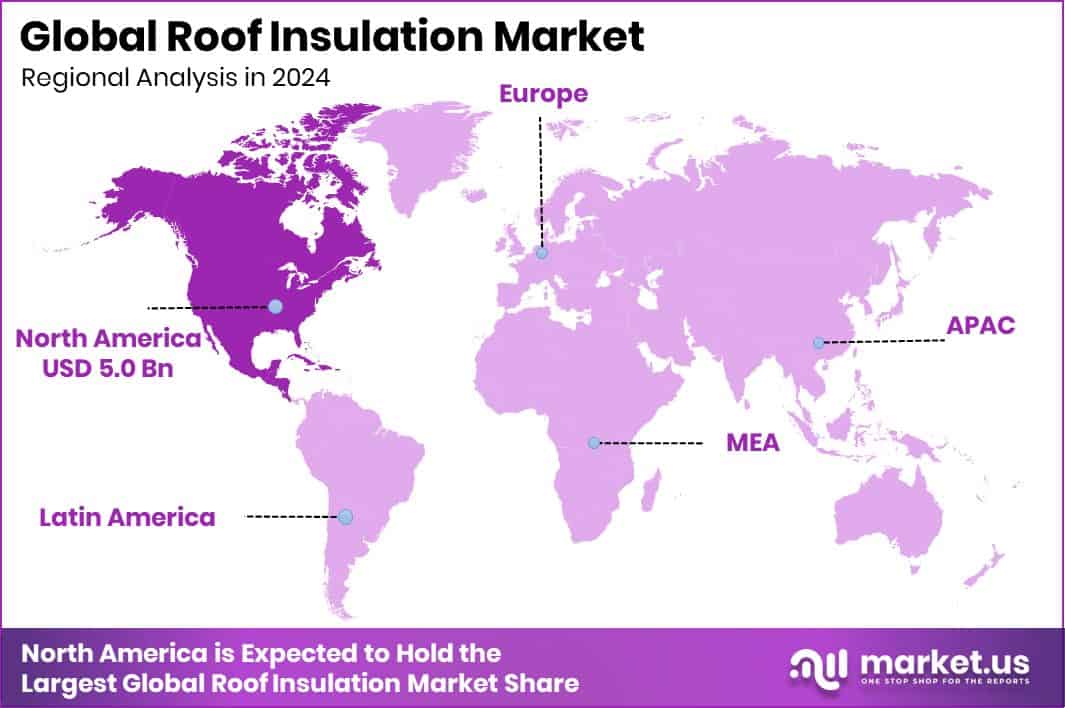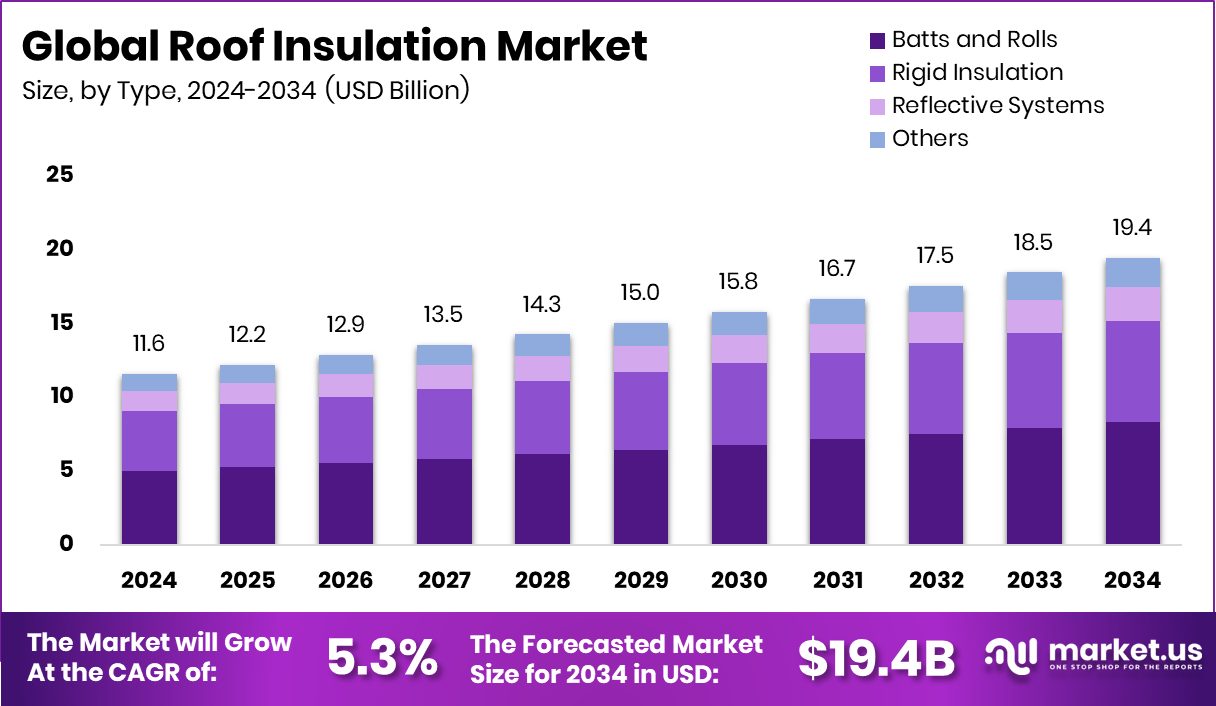Report Overview
The Global Roof Insulation Market is expected to be worth around USD 19.4 billion by 2034, up from USD 11.6 billion in 2024, and is projected to grow at a CAGR of 5.3% from 2025 to 2034. North America’s dominance of USD 5.0 Bn reflects rising energy efficiency demand and supportive building regulations.
Roof insulation is a protective layer added beneath or above the roof structure to regulate temperature and improve energy efficiency. It helps keep homes warmer in the winter and cooler in the summer by reducing heat transfer. Beyond comfort, roof insulation lowers energy bills and reduces greenhouse gas emissions, making it a key part of sustainable building practices.

The roof insulation market is growing as more people and governments recognize the need for energy-efficient solutions. Rising energy costs and stricter building regulations are pushing homeowners and industries to invest in better insulation. According to an industry report, the government has launched a £1 billion drive through the Great British Insulation Scheme to help those most in need heat their homes for less. Such programs highlight how funding and public policies directly support market growth.
One of the main growth factors is the increasing demand for sustainable housing and the retrofitting of old buildings. Communities and schools are also stepping forward, such as when Gill seeks a $915K grant to upgrade a school roof with insulation and solar panels. This shows how insulation is often combined with renewable energy to maximize efficiency.
Demand for roof insulation is also driven by public infrastructure upgrades. The next phase of £1 million energy-saving improvements at Penrith Leisure Centre is an example of how commercial and recreational spaces are being modernized to cut energy use and operating costs. These projects underline that roof insulation is not only a household solution but also a community-wide priority.
Looking ahead, opportunities in the market will expand as climate targets tighten and more funding schemes roll out. Governments, schools, and commercial centers continue to invest in large-scale upgrades, while individual homeowners see long-term financial savings. With energy efficiency becoming a global necessity, the roof insulation market is positioned for steady and sustainable growth.
Key Takeaways
- The Global Roof Insulation Market is expected to be worth around USD 19.4 billion by 2034, up from USD 11.6 billion in 2024, and is projected to grow at a CAGR of 5.3% from 2025 to 2034.
- In the roof insulation market, batts and rolls account for 42.9% of product demand.
- Stone wool leads material preference in the roof insulation market, holding a strong 32.7% share.
- Flat roof applications dominate the roof insulation market, representing 59.3% of total installations.
- The North American market value reached USD 5.0 Bn, showing strong growth.
By Type Analysis
The roof insulation market by batts and rolls holds a 42.9% share.
In 2024, Batts and Rolls held a dominant market position in the By Type segment of the Roof Insulation Market, with a 42.9% share. This strong position highlights the widespread use of batts and rolls as a preferred insulation material due to their cost-effectiveness, ease of installation, and ability to provide reliable thermal performance across residential and commercial buildings. Their dominance is also linked to the growing demand for retrofitting older properties and meeting modern energy efficiency standards.
The material’s adaptability to different roof structures has further reinforced its market leadership, making it the go-to solution in large-scale projects where affordability and performance must align with government-backed energy-saving initiatives.
By Material Analysis
Stone wool leads the material segment in the roof insulation market, capturing 32.7%.
In 2024, Stone Wool held a dominant market position in the By Material segment of the Roof Insulation Market, with a 32.7% share. This leading position reflects its effectiveness in delivering both thermal and acoustic insulation, making it a preferred choice for diverse construction needs. Stone wool’s fire-resistant properties and durability provide added value, particularly in buildings where safety and long-term performance are key considerations.
Its ability to perform well under varying climate conditions has further strengthened its adoption across roofing applications. The strong market presence of stone wool underscores its balance of energy efficiency, safety, and sustainability, ensuring it remains a trusted material in both residential and commercial insulation projects.
By Application Analysis
Flat roof applications dominate the roof insulation market with a 59.3% share.
In 2024, Flat Roof held a dominant market position in the By Application segment of the Roof Insulation Market, with a 59.3% share. The dominance of flat roof applications is closely tied to their extensive use in commercial and industrial buildings, where large surface areas make insulation crucial for controlling energy costs and maintaining indoor comfort.
Flat roofs often require high-performing insulation solutions to withstand weather variations, reduce heat loss, and support sustainability goals. Their suitability for retrofitting projects has also reinforced their strong market share. The significant preference for flat roof insulation highlights its role in meeting energy efficiency standards and driving cost savings across large-scale infrastructure and property developments.

Key Market Segments
By Type
- Batts and Rolls
- Rigid Insulation
- Reflective Systems
- Others
By Material
- Stone Wool
- Glass Wool
- Foamed Plastic
- Others
By Application
Driving Factors
Rising Demand for Energy-Efficient Buildings Globally
One of the biggest driving factors for the roof insulation market is the rising need for energy-efficient buildings. With growing awareness about climate change and increasing energy bills, both governments and households are focusing on ways to reduce energy consumption. Roof insulation plays a key role by keeping homes warmer in winter and cooler in summer, lowering heating and cooling costs.
Supportive policies and funding initiatives are further boosting this demand. For instance, Fiber Elements raised €2.6 million in seed funding to advance its 3D basalt fiber technology, showing how innovation is supported to improve insulation solutions. These efforts highlight how funding, technology, and sustainability together drive strong growth in the roof insulation market.
Restraining Factors
High Installation Costs Limit Wider Market Adoption
A major restraining factor for the roof insulation market is the high cost of installation. While insulation helps save money on energy bills over time, the upfront expenses for materials and labor can be difficult for many homeowners and small businesses to manage. This challenge is more visible in developing regions where budgets are tight and awareness about long-term savings is still limited.
Skilled labor requirements and the need for proper fitting also add to the costs, making the process less affordable. As a result, some property owners delay or avoid insulation upgrades, slowing down market adoption even though the benefits are clear for comfort, safety, and energy efficiency.
Growth Opportunity
Technological Innovations Creating New Market Opportunities
A key growth opportunity in the roof insulation market lies in the adoption of advanced technologies and new materials. As sustainability becomes a global priority, developers and researchers are focusing on creating insulation solutions that are lighter, stronger, and more efficient.
Innovations such as eco-friendly fibers, recycled materials, and smart insulation systems open new doors for reducing energy loss while enhancing building safety. For example, Relativity Networks secured $6.1 million during its latest seed funding to develop hollow core fiber technology, showcasing how funding is driving the next generation of high-performance materials. These advancements provide the market with opportunities to meet stricter environmental regulations while catering to the rising demand for energy-efficient buildings worldwide.
Latest Trends
Growing Focus on Sustainable and Smart Insulation Solutions
One of the latest trends in the roof insulation market is the growing focus on sustainable and smart insulation materials. Builders and consumers are increasingly shifting toward eco-friendly solutions that not only save energy but also reduce environmental impact. This includes insulation made from recycled materials, natural fibers, and smart systems that adjust to temperature changes for better efficiency.
Governments and institutions are also playing a role by supporting innovation in clean energy and related fields. For instance, the DOE announced new $1.65 million incubator program funding for 18 research projects to advance wind energy, highlighting how funding in renewable and energy-saving technologies supports the wider ecosystem where roof insulation continues to evolve.
Regional Analysis
In 2024, North America held a 43.90% share of the Roof Insulation Market.
The Roof Insulation Market shows diverse growth patterns across major global regions, each shaped by local energy efficiency needs and construction activities. North America dominated the market in 2024 with a 43.90% share, valued at USD 5.0 billion, supported by strict building codes, rising retrofitting projects, and government-backed energy-saving initiatives. This leadership highlights the region’s strong focus on reducing energy consumption and carbon emissions through better insulation practices.
Europe follows with a solid presence, driven by its long-standing emphasis on sustainable construction and ambitious climate goals that encourage the adoption of eco-friendly insulation materials.
The Asia Pacific region is witnessing steady expansion, fueled by rapid urbanization, growing construction in emerging economies, and increasing awareness of energy efficiency.
Meanwhile, the Middle East & Africa region is gradually adopting roof insulation solutions to cope with extreme weather conditions and rising infrastructure projects, though the market here remains at an early stage.
Latin America also contributes modestly, with insulation demand linked to residential upgrades and commercial construction activities. Collectively, while all regions are contributing to market growth, North America clearly stands out as the dominant region due to its high adoption rate, strong regulatory support, and significant market value.

Key Regions and Countries
- North America
- Europe
- Germany
- France
- The UK
- Spain
- Italy
- Rest of Europe
- Asia Pacific
- China
- Japan
- South Korea
- India
- Australia
- Rest of APAC
- Latin America
- Brazil
- Mexico
- Rest of Latin America
- Middle East & Africa
- GCC
- South Africa
- Rest of MEA
Key Players Analysis
BASF has been recognized for its strong role in chemical-based insulation materials, focusing on delivering products that enhance thermal efficiency while meeting sustainability goals. Its expertise in advanced materials continues to influence the adoption of high-performing insulation systems, aligning with global energy-saving priorities.
Berkshire Hathaway, with its portfolio spanning building materials and construction-related businesses, maintains a significant role in roof insulation demand. The company’s focus on durable and reliable materials has ensured its steady presence in both residential and commercial applications. Its ability to leverage scale and long-term investments allows it to respond effectively to shifting insulation requirements.
Rockwool International remains a leader in stone wool insulation, with products well-regarded for their thermal, acoustic, and fire-resistant qualities. In 2024, the company continues to strengthen its position by offering sustainable solutions suited to varied climates and applications. Stone wool’s durability and environmental benefits further reinforce Rockwool’s competitive standing in the global market.
Top Key Players in the Market
- BASF
- Berkshire Hathaway
- Rockwool International
- Paroc
- Kingspan
- Owens Corning
- Knauf Insulation
- Saint-Gobain
- GAF
- Beijing New Building Material
Recent Developments
- In February 2025, Rockwool announced it would invest over USD 100 million to add a new production line at its Marshall County, Mississippi, facility. The line will produce insulation products using its WR-Tech™ (water repellency) and CR-Tech™ (corrosion resistance) technologies.
- In January 2024, BASF partnered with Carlisle Construction Materials to develop Lupranate ZERO, a zero-carbon footprint isocyanate, aiming to produce polyisocyanurate (PIR) insulation boards with lower emissions.
Report Scope
